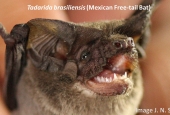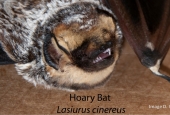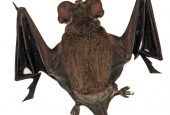Bats are the only mammals that have the ability to fly. Like other mammals, they are warm blooded, have fur, produce milk, and give birth to live young. Their wings are formed from thin, leathery skin stretched between their arm, wrist and finger bones. Most bats found in Alameda County have a wingspan averaging between 8 and 14 inches and are dark-colored with brown or black fur. In total, there are 23 species of bats in California, and they are quite diverse in appearance and habitat preference. A variety of them can be found here in Alameda County.
Bats are nocturnal animals, and as such, are active and feeding during the night hours. During the day, they roost in dark, sheltered places including caves, rock crevices, under bridges, in buildings, and in other dark, protected areas, usually in groups. Bats feed primarily on insects and use echolocation to find their prey in the air and sometimes on the ground. They are an important natural predator of many nuisance insects. Like many birds, bats can migrate long distances to new roosting sites depending on the season and their individual ecological needs.
Bats are of great public health concern due to their ability to carry and transmit the rabies virus. In the past few decades, they have become the most common wildlife rabies carrier in California, followed by skunks. Regardless of where they are found or what condition they are in (dead, sick or alive), they should never be handled by the general public due to the risk of infection through a bite or contact with saliva. Their droppings (called guano) can also contain a species of fungus that causes a disease called histoplasmosis. Histoplasmosis is a lung disease caused by inhaling spores of the
Histoplasma fungus that grows in bat guano. Bats can also be hosts to mites, ticks, fleas, and bat bugs that may disperse into buildings where they are roosting.
We emphasize that: A live bat found in or around a building during the daytime may be sick and should be avoided and reported to us or local animal control!
Although some bats are protected in California, the only species of special concern is the rare Townsend’s big eared bat. If this bat enters your home, avoid direct contact. While watching the bat close doors to other rooms, and allow the bat to exit through an open door or window. If necessary, cautiously approach the bat and capture it with a net or box to release it outdoors.
Exclusion is the best way to bat-proof your home. Seal and repair any cracks or crevices that lead into dark areas where bats may find a suitable roosting site. If you are working to exclude bats that are already established at your home, our biologists can work with you to discuss exclusion techniques that will allow the bats to exit unharmed without being able to re-enter.
 Types of Bats in Alameda County
Types of Bats in Alameda County





